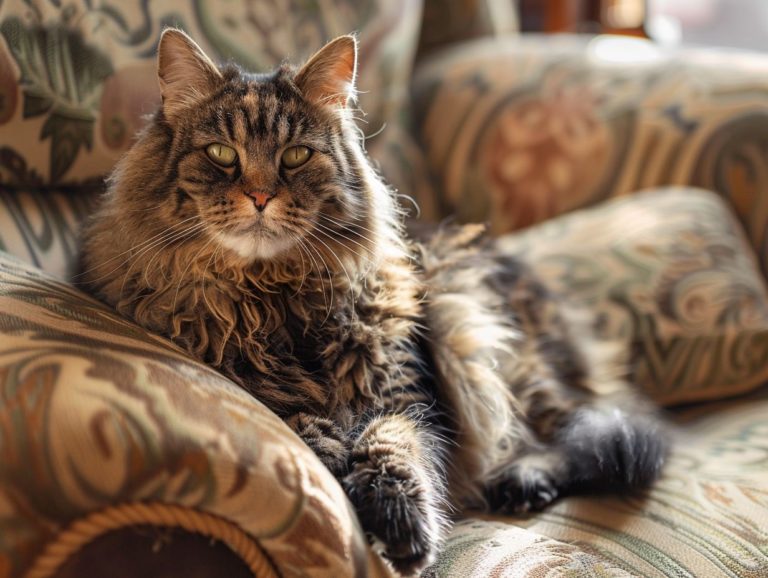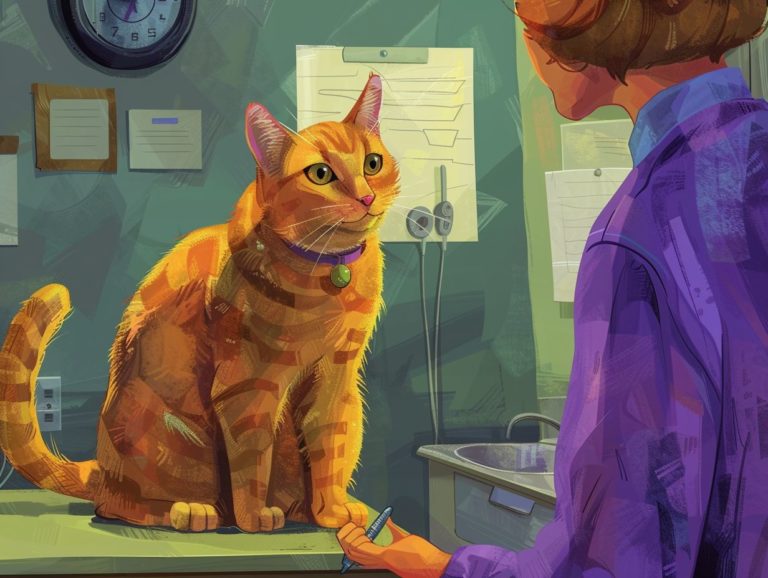The Benefits Of Annual Vs Monthly Premiums In Cat Insurance
This article discusses the types of cat insurance coverage, the advantages and disadvantages of annual premiums, the pros and cons of annual deductibles, the pros and cons of monthly premiums, and factors to consider when deciding on premium frequency.
By reading this article, you can gain a better understanding of cat insurance and make an informed decision based on factors such as your personal financial situation, your pet’s age and health status, and your coverage needs.
Key Takeaways:
Understanding Cat Insurance
It is important for pet owners to understand Cat Insurance as it serves as the financial means to ensure that their cats receive necessary veterinarian care. Cat insurance provides coverage for various medical expenses as outlined in the policy terms, including annual limits, deductibles, and reimbursements.
There are different cat insurance policies offering varying degrees of coverage, ranging from basic accident-only plans to comprehensive coverage that includes accidents, illnesses, hereditary conditions, and preventive care. Pet owners can select the coverage level that aligns with their budget and their cat’s specific medical needs.
Annual limits can differ among cat insurance policies, with some having no annual limits while others do. Deductibles also vary, allowing pet owners to choose the amount they are willing to pay towards each veterinary visit before the insurance covers the remaining bill.
What is Cat Insurance?
Cat Insurance
Cat Insurance is a financial product offered by insurance companies to assist pet owners in managing veterinary care expenses for their cats. It encompasses coverage for medical costs such as surgeries, treatments, and medications, subject to specific deductible and reimbursement criteria.
Cat insurance consists of various policy types, ranging from basic to comprehensive options. Basic policies may cover only certain medical treatments, while more comprehensive plans may include additional services like dental care or acupuncture.
Deductible amounts represent the out-of-pocket expenses that pet owners must pay before insurance coverage takes effect, with lower deductibles generally corresponding to higher premium costs.
Reimbursement percentages denote the portion of covered expenses that the insurance company will reimburse to the pet owner once the deductible has been met, typically ranging from 70% to 90%.
Cat insurance is essential for pet owners as it offers financial protection and peace of mind in the event of unforeseen accidents or illnesses. It provides assurance that their cats will receive necessary care during emergencies without imposing significant financial strain.
Types of Coverage Available
Cat insurance policies offer a range of coverage options, from basic plans that cover core veterinary expenses to comprehensive plans with higher annual limits and reimbursement rates for a broader range of medical costs. These flexible coverage options enable cat owners to select a policy that aligns with their budget constraints and desired level of protection.
Basic plans provide affordable coverage for routine veterinary check-ups, vaccinations, and preventive care, while comprehensive plans expand coverage to include emergency treatments, chronic conditions, and sometimes alternative therapies. Varying annual limits and reimbursement structures across these policies allow pet owners to tailor their choice based on budget considerations and the potential health risks their cat may encounter.
Pros and Cons of Annual Premiums
Understanding the pros and cons of annual premiums for Cat Insurance can assist cat owners in making more informed decisions about their insurance coverage. Annual premiums offer the benefit of consistent costs throughout the year, ensuring continuous coverage for their cats’ potential medical expenses. This can be particularly advantageous as it eliminates concerns about potential fluctuations in monthly premiums.
Additionally, annual payments may streamline the reimbursement process by reducing the frequency of paperwork and administrative tasks. On the downside, the lump sum payment required by annual premiums can pose a significant expense at the beginning of the policy period, which may be challenging for individuals on tighter budgets.
Benefits of Paying Annually
Opting for annual premiums in Cat Insurance offers several advantages to pet owners, including cost savings, faster claims reimbursement processes, continuous coverage, and the potential for lower overall insurance costs.
When pet owners choose to pay their cat insurance premiums annually, they benefit from a one-time upfront payment that often includes a discounted rate compared to monthly installments. This cost-effectiveness not only saves money but also simplifies the pet owner’s financial planning process, eliminating the need to keep track of monthly payment dates. Explore the options of annual cat insurance plans for more information.
Opting for annual premiums ensures uninterrupted coverage, providing peace of mind to cat owners in case of unexpected health issues or accidents. This payment schedule is convenient and aligns well with the busy lives of pet owners, offering an easy way to manage their cat’s insurance needs.
Potential Drawbacks
In Cat Insurance, the potential drawbacks of annual premiums include higher upfront costs, the obligation to pay for a full year, and a lack of flexibility in adjusting coverage to align with the evolving insurance needs of your pet.
While annual premiums can offer stable pricing and coverage for your cat throughout the year, they also entail a significant initial financial commitment that may pose challenges for many pet owners. The requirement to pay for the entire year can be problematic if circumstances change or if the pet owner decides to switch to a different insurance provider.
The inability to modify coverage to address changing pet health needs is the primary drawback. To address these issues, it is advisable to opt for monthly premium payments as they offer greater flexibility and financial management, enabling you to adjust coverage as necessary and discontinue at any time.
Pros and Cons of Monthly Premiums
In Cat Insurance, the advantages of monthly premiums include giving owners the flexibility to choose how they pay for their policy, allowing them to make smaller, more frequent payments. This can be beneficial for those needing to budget and manage the costs of ongoing veterinary care.
Opting for monthly premiums enables pet owners to spread out the expense of their cat’s insurance over time, making it more manageable and easier to incorporate into their monthly financial planning. This flexibility offers peace of mind knowing that your cat is covered without the need for a large upfront payment, simplifying the financial aspects of pet ownership and allowing you to focus on your cat’s health without concerns about unexpected veterinary expenses.
Benefits of Paying Monthly
Opting for monthly premiums in Cat Insurance offers several advantages, including easier affordability through monthly budgeting, immediate coverage, customization for different coverage levels, and alignment with pet owners’ typical monthly financial planning.
This payment method breaks down the annual premium into manageable monthly chunks, making it easier for pet owners to budget for their cat’s insurance needs. By choosing monthly premiums, cat owners ensure quick coverage initiation, protecting their furry companions from unexpected medical expenses.
Customization options available with monthly payments allow pet owners to tailor their coverage to meet their cat’s specific needs, providing peace of mind knowing their beloved pet is well-protected. Selecting monthly premiums in Cat Insurance is a wise choice for cat owners looking to meet their feline’s financial and healthcare requirements.
Potential Drawbacks
The disadvantages of monthly premiums in Cat Insurance relate to higher administrative fees increasing overall costs, the risk of missed payments resulting in uncovered medical expenses, and the unpredictability of monthly budgeting for pet owners.
These administrative fees, linked with monthly premium payments, can accumulate over time and lead to higher expenses compared to annual payment alternatives. Failure to make a monthly payment may cause a lapse in coverage, leaving your cat vulnerable to unexpected medical costs.
Managing numerous monthly payments can be challenging for pet owners, potentially causing confusion and missed payment deadlines. To address these drawbacks, some insurance providers offer discounts for annual payments or automatic payment options to ensure continuous coverage for your cat.
Factors to Consider When Choosing Premium Frequency
When choosing the premium frequency of their Cat Insurance policy, factors that pet owners should consider include their personal financial situations, the health and age of their cat, and their specific coverage needs to ensure comprehensive veterinary care.
Annual premium payments may be more immediately costly but generally offer savings over the long run compared to monthly premiums, providing financial stability and predictability for pet owners.
Monthly premiums offer flexibility to manage budgets better, which may be especially important for those with variable incomes.
Pet owners should take into account the current health status of their cat as well as any preexisting medical conditions to decide on the level of coverage needed.
The age of the cat should also be considered, as older cats may require more frequent veterinary visits and specialized care.
Personal Financial Situation
When determining the optimal premium frequency for Cat Insurance, pet owners consider personal financial variables as the most important factors. Factors such as income stability, budget constraints, and emergency savings can influence the choice between annual and monthly payments.
It is crucial to consider significant budget constraints and assess whether pet owners have the financial capacity to make a large annual payment or prefer the flexibility of monthly installments within their budget. Income stability also plays a key role, with a steady income making monthly payments easier to budget, while fluctuating earnings may align better with larger annual premiums.
The presence of an emergency savings fund can further impact the decision, as it can provide a financial safety net and make annual payments more feasible by offering savings to cover any unexpected insurance-related expenses.
Health and Age of Cat
The premium frequency for Cat Insurance is influenced by the health and age of the cat. Older cats or those with preexisting health conditions may require more frequent monthly payments to maintain constant coverage of potential medical problems.
Regular visits to the vet and preventative care are crucial in older cats to maintain their health, as this can help detect problems before they get worse.
When they reach their senior years, cats are at a higher risk of developing age-related diseases such as diabetes or kidney disease, and broad insurance coverage is important.
Adapting the insurance plan to tackle specific health conditions or issues related to age will ensure that the cat can receive the care and treatment it needs when it needs it, providing pet owners with peace of mind.
Coverage Needs
It is important for pet owners to understand the coverage needs of their cats in order to determine the frequency of premium payments for Cat Insurance. Assessing the required level of protection, deductible preferences, and reimbursement expectations can assist pet owners in deciding between annual and monthly premium payments. Pet owners can also customize their insurance plans based on specific requirements, such as including coverage for pre-existing conditions, wellness visits, or alternative therapies like acupuncture or chiropractic care. This customization enables pet owners to provide their cats with the best care while managing costs effectively.
Frequently Asked Questions
What are the benefits of choosing annual premiums for cat insurance?
Annual premiums for cat insurance offer cost savings in the long run. By paying a lump sum once a year, you can avoid monthly processing fees and potentially receive a discount from your insurance provider.
Can I switch from monthly to annual premiums for my cat’s insurance?
Yes, many insurance providers allow you to switch from monthly to annual premiums, typically at the start of a new policy term. Keep in mind that there may be a fee for changing your payment schedule.
Are there any disadvantages to choosing annual premiums for cat insurance?
The main disadvantage of annual premiums is the upfront cost. While you may save money in the long run, it can be a larger financial burden to pay the full amount at once compared to monthly payments.
Do annual premiums provide better coverage for cat insurance?
No, the coverage for cat insurance remains the same whether you choose annual or monthly premiums. However, paying annually may give you access to additional perks or discounts from your insurance provider.
Is there a specific age or health condition that may make annual premiums more beneficial for cat insurance?
Not necessarily. The benefits of choosing annual premiums are dependent on your individual financial situation and preferences. It may be more beneficial for some pet owners to pay annually, while others may prefer the flexibility of monthly payments.
Are there any other factors to consider when deciding between annual and monthly premiums for cat insurance?
Yes, it’s important to also consider your budget and ability to pay for unexpected vet expenses. Annual premiums may offer cost savings, but if you are on a tight budget, monthly payments may be a more manageable option. Additionally, if your cat has a pre-existing condition, it may be more beneficial to choose monthly premiums to avoid being locked into a policy for a full year.


